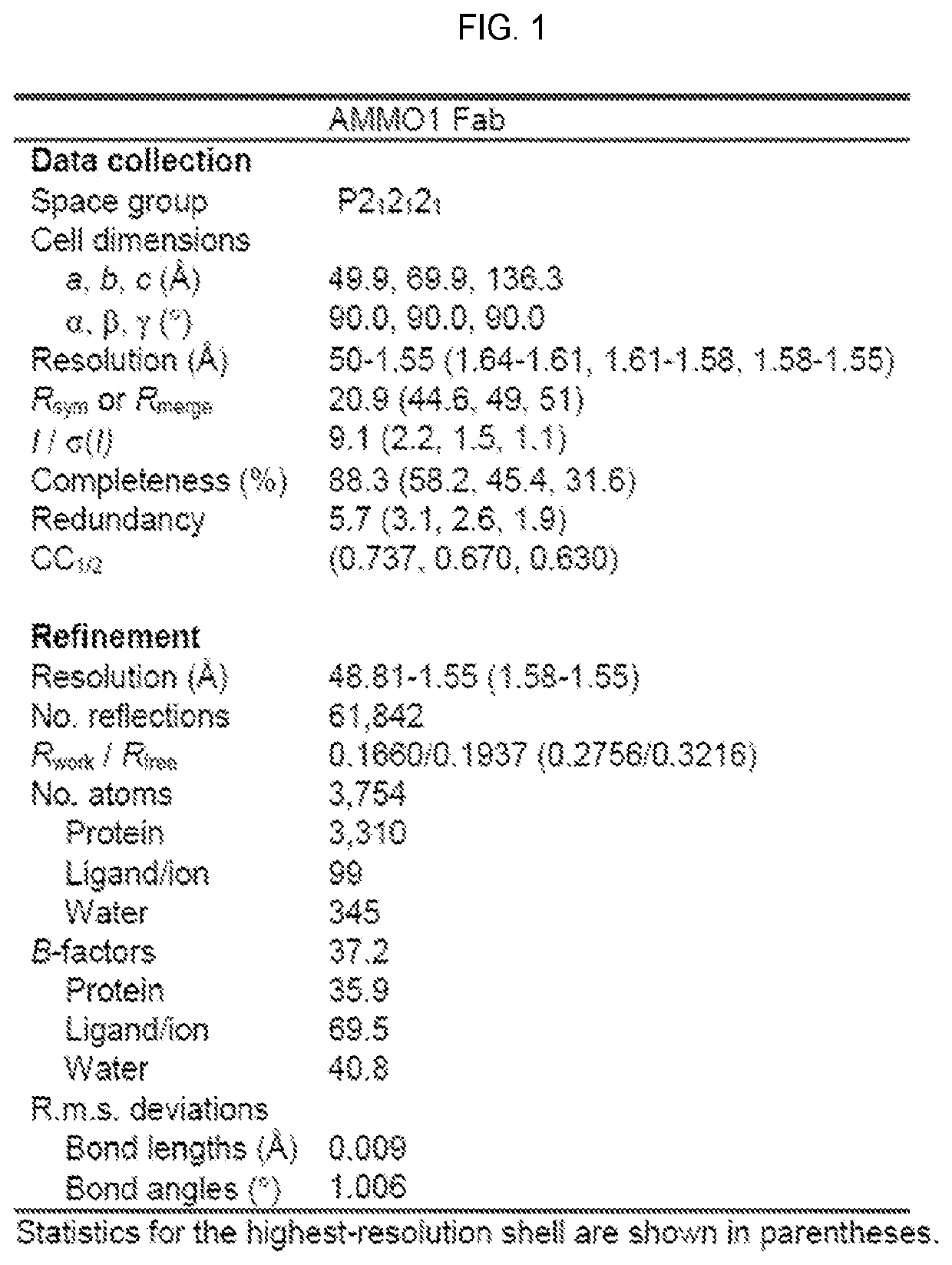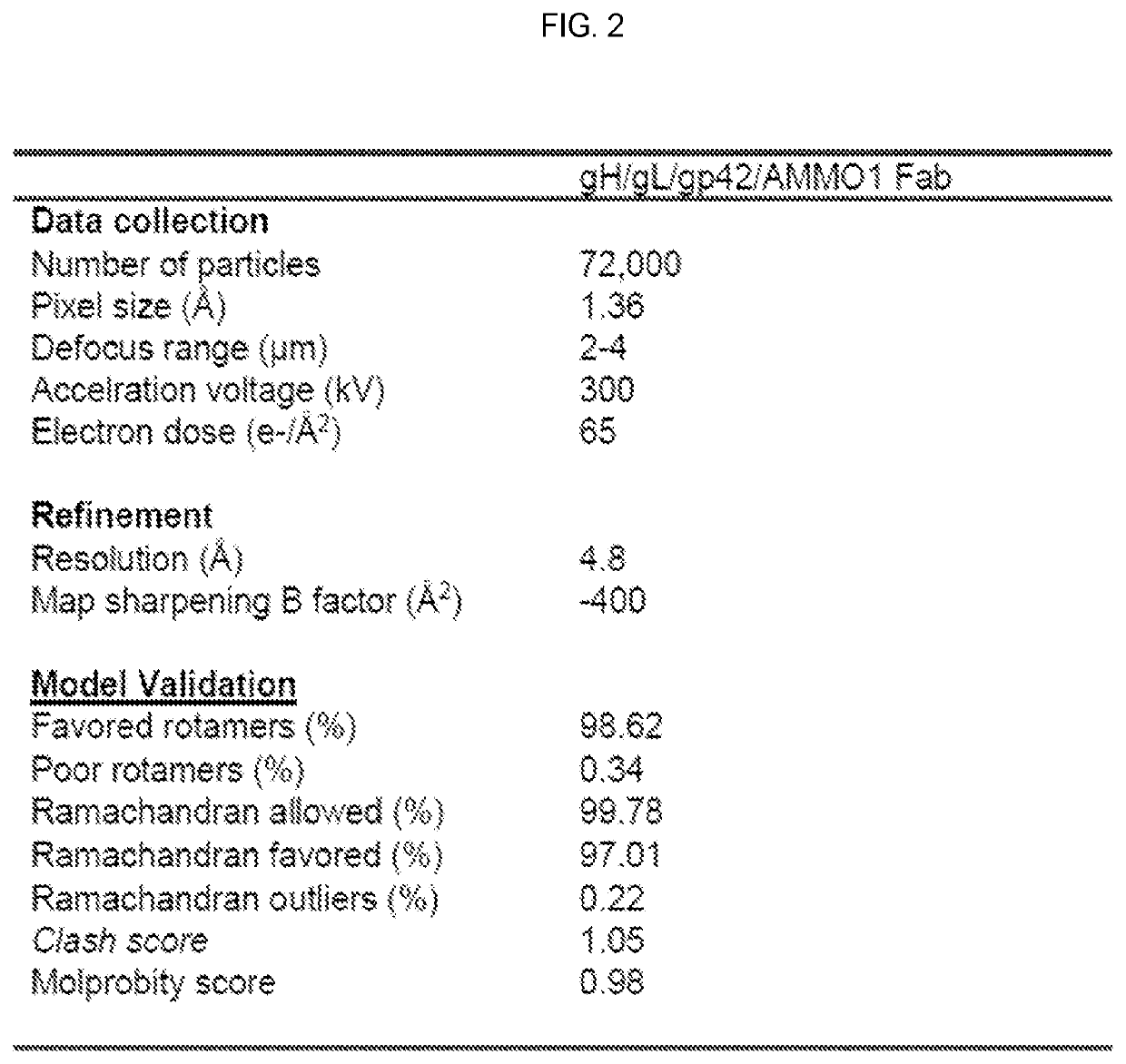Epstein barr virus antibodies, vaccines, and uses of the same
a technology antibodies, which is applied in the field of epstein barr virus antibodies, vaccines, and uses of the same, can solve the problems of ineffective human neutralizing antibody against ebv, cancer or cancer-like diseases, and inability to protect from ebv infection, so as to reduce the risk of nasopharyngeal carcinoma and reduce the ebv infection
- Summary
- Abstract
- Description
- Claims
- Application Information
AI Technical Summary
Benefits of technology
Problems solved by technology
Method used
Image
Examples
example 1
(XI) Example 1
[0295]In particular embodiments, the anti-EBV antibodies have one or more of the following characteristics:[0296]A) bind to recombinant and / or wild-type gH / gL;[0297]B) bind residues 60, 70-81, 211-216, and 234-239 of gH; and residues 123-128 of gL;[0298]C) bind residues 73 and 76 of gH wherein residue 73 is lysine and residue 76 is tyrosine;[0299]D) bind to endogenous gH / gL on the surface of an EBV virion;[0300]E) compete for gH / gL binding with the CL40 antibody;[0301]F) bind to gH D-I / D-II linker region, as well as the gL C-terminus;[0302]G) dissociate from EBV gH / gL with a KD of 1×10−10 or less and a koff rate constant of 3×10−5 s-1 or less, both determined by surface plasmon resonance or biolayer interferometry;[0303]H) bind to wild-type gH / gL with a KA of more than 1×107M−1, more than 100×107M−1, more than 200×107M−1 or more than 500×107M−1;[0304]I) bind to recombinant and / or wild-type gB;[0305]J) bind to endogenous gB on the surface of an EBV virion;[0306]K) reduc...
example 2
[0315]An anti-gH / gL antibody that neutralizes dual-tropic infection defines a site of vulnerability on Epstein-Barr virus. Epstein-Barr virus (EBV) infects the majority of adults worldwide. Although most primary infections are asymptomatic, EBV is a causative agent of infectious mononucleosis in children and young adults, and is associated with numerous hematopoietic and epithelial cell cancers (Cohen et al., 2011; Young and Rickinson, 2004). EBV also causes lymphoproliferative disorders in immunocompromised patients such as those with HIV / AIDS or in patients undergoing immune suppression for organ transplantation (Taylor et al., 2015). Thus, a vaccine that prevents EBV infection would be of major benefit to public health (Cohen et al., 2011). EBV targets B cells and epithelial cells during primary infection. Host cell entry is a complex process mediated by several viral glycoproteins that define tropism and mediate membrane fusion at the plasma membrane during epithelial cell infec...
example 3
[0414]Human hematopoietic progenitor stem cells engrafted in immunocompromised mice develop into human B cells that can be infected with EBV. A low EBV dose results in persistent latent infection that mimics natural human infection, while a higher dose results in a lymphoproliferative disease state. As a proof of concept that disclosed antibodies protect from infection, B cells were harvested from these mice and challenged with a low-dose EBV reporter virus that induces GFP expression upon infection. The absence of antibody could readily be detected (FIG. 23A, left), yet there was no evidence of infection in the presence of AMMO1 (FIG. 233A, right).
[0415]Next, the ability of AMMO1 to protect against EBV in vivo was assessed. 0.5 mg AMMO1 or an irrelevant anti-HIV MAb was administered to humanized mice 2 days prior to a high dose (5×IC50) intravenous EBV challenge. 6 weeks later, nearly all of the human B cells (hCD45+,hCD19+) in the blood had died in mice that received the control a...
PUM
| Property | Measurement | Unit |
|---|---|---|
| box size | aaaaa | aaaaa |
| dissociation constant | aaaaa | aaaaa |
| dissociation constant | aaaaa | aaaaa |
Abstract
Description
Claims
Application Information
 Login to View More
Login to View More - R&D
- Intellectual Property
- Life Sciences
- Materials
- Tech Scout
- Unparalleled Data Quality
- Higher Quality Content
- 60% Fewer Hallucinations
Browse by: Latest US Patents, China's latest patents, Technical Efficacy Thesaurus, Application Domain, Technology Topic, Popular Technical Reports.
© 2025 PatSnap. All rights reserved.Legal|Privacy policy|Modern Slavery Act Transparency Statement|Sitemap|About US| Contact US: help@patsnap.com



